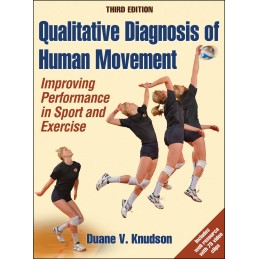- Reduced price

Order to parcel locker

easy pay


 Delivery policy
Delivery policy
Choose Paczkomat Inpost, Orlen Paczka, DHL, DPD or Poczta Polska. Click for more details
 Security policy
Security policy
Pay with a quick bank transfer, payment card or cash on delivery. Click for more details
 Return policy
Return policy
If you are a consumer, you can return the goods within 14 days. Click for more details
For kinesiology professionals, qualitative movement diagnosis (QMD) is a critical skill in helping individuals improve performance or reduce the risk of injury. Qualitative Diagnosis of Human Movement:: Improving Performance in Sport and Exercise, Third EditionWith Web Resource, focuses on the processes behind movement observation, assessment, and diagnosis, emphasizing how to recognize and correct errors in human movement. This unique text teaches anyone working in human movement–related professions how to integrate and apply knowledge from the fields of kinesiology, allied health, and engineering to help clients, patients, or athletes improve their movement performance or move with a lower risk of injury.
Well received by scholars worldwide, the previous editions, formerly titled Qualitative Analysis of Human Movement, broke new ground as the first texts devoted to QMD. The third edition continues building on that foundation with a new title, Qualitative Diagnosis of Human Movement, to better reflect the diagnostic and corrective aspects of this critical skill. Following are other improvements to this edition::
• A web resource replaces the CD-ROM from the previous edition and contains more than 70 all-new video clips and follow-up questions to provide real-life examples to practice movement diagnosis.
• Expanded coverage of the use of video and computer technology shows readers how to use modern tools to aid in observation and evaluation of movement.
• An additional 80 new sources of research relevant to QMD illustrate the extent to which this area of study has taken hold in the kinesiology field.
As in previous editions, Qualitative Diagnosis of Human Movement, Third Edition, organizes research-based knowledge into a simple theoretical structure supplemented with numerous examples of application. It introduces a four-task interdisciplinary model of QMD—preparation, observation, evaluation and diagnosis, and intervention—and summarizes the development of this approach and the perceptual factors relevant to movement diagnosis. Readers are then led through a series of tutorials that provide real-world examples. These practice scenarios will help readers better understand the process from beginning to end as they review photos in the book in QMD Practice sections (with accompanying video in the web resource or video-enhanced e-book), and then perform their own movement diagnosis by viewing video from the web resource or video-enhanced e-book in QMD Explorations.
In addition, a chapter titled Theory-Into-Practice Situations provides case studies spanning a variety of movement, fitness, and sport settings. These case studies are featured in both the book and the web resource as printable forms that offer readers support in developing their own plan to assist the subject in the case study. Several other features such as QMD Technologies and QMD Demonstration sideboxes add more tools to show students how QMD can help clients in real-world sessions. For instructors, an image bank containing the book’s prominent figures, tables, and photos is available for use in delivering lectures.
Qualitative Diagnosis of Human Movement, Third Edition, provides students, teachers, and researchers with a practical diagnostic framework, tutorials to guide them through the QMD process, advice on capturingg relevant information from motor performances, and descriptions of intervention strategies. The updated edition and the unique web resource are invaluable tools capable of sharpening the skills of even experienced diagnosticians. This text will assist readers in integrating their knowledge of all kinesiology subdisciplines in order to develop or improve their skills in QMD and better serve their clients, patients, and athletes.
Data sheet
Part I. An Integrated Approach to Qualitative Movement Diagnosis
Chapter 1. Interdisciplinary Nature of Qualitative Movement Diagnosis
QMD in Kinesiology
Interdisciplinary Nature of QMD
Integrated Model of QMD
Summary
Discussion Questions
Chapter 2. Models in Qualitative Movement Diagnosis
Classifying Models of QMD
Overview of History and Models of QMD
Validity and Reliability of QMD
Summary
Discussion Questions
Chapter 3. Role of the Senses and Perception in Qualitative Movement Diagnosis
Theoretical Background for Senses and Perception in QMD
Senses
Using Senses to Understand Movement
Integration of Senses
Knowledge and Perception
A Gestalt
Summary
Discussion Questions
Part II. Four Tasks in the Diagnosis and Improvement of Human Movement
Chapter 4. Preparation: Gathering Relevant Knowledge
Knowledge of Activity
Knowledge of Performers
Knowledge of Effective Instruction
Preparing for the Next Task
Summary
Discussion Questions
Chapter 5. Observation: Developing a Systematic Observational Strategy
Proposals for Observational Strategies
Key Elements in a Systematic Observational Strategy
Integrated Use of All Senses
Summary
Discussion Questions
Chapter 6. Evaluation and Diagnosis: Professional Critical Thinking
Evaluation
Diagnosis
Further Practice
Summary
Discussion Questions
Chapter 7. Intervention: Strategies for Improving Performance
Feedback
Beyond Traditional Feedback
Further Practice
Summary
Discussion Questions
Part III. Practical Applications of Human Movement Diagnosis
Chapter 8. Video Replay Within Qualitative Movement Diagnosis
Introduction to Video Replay in Kinesiology
Video Technology
Making Videos for QMD
Video and Computers in QMD
Further Practice
Summary
Discussion Questions
Chapter 9. Tutorials in Qualitative Movement Diagnosis
QMD of Catching
QMD of the Soccer Instep Kick
QMD of Overarm Throwing
QMD of the Disk (Frisbee) Throw or Toss
QMD of the Squat Exercise
QMD Explorations
Summary
Discussion Questions
Chapter 10. Theory-Into-Practice Situations
“Cleared to Play”
Theory-to-Practice Situations for QMD
Further Practice
Summary
Discussion Questions
